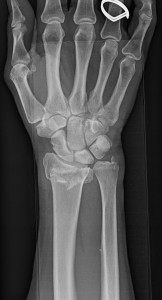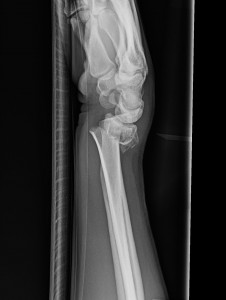If you recently hurt your wrist and the emergency room or urgent care doctor told you that you broke a bone in your wrist, I am sure that you have a lot of questions. While you are waiting for your follow-up appointment with an orthopedic surgeon, you may be wondering several things including: do I need surgery, how long with this take to heal, and will my hand ever be the same?
The most common bone to break or fracture in the wrist is the end of the radius bone, called the “distal radius.” There is an area within the distal radius bone which is naturally weaker than the surrounding structures, making it more likely to fracture. These fractures often occur in women after menopause. A simple trip and fall on an outstretched hand can be enough trauma to fracture the bone in patients with osteoporosis.
Orthopedic surgeons frequently treat patients with distal radius fractures. Fortunately, most of these injuries heal in time without surgery. Patients are typically treated in a cast for several weeks as the bones heal, the swelling subsides, and the pain diminishes. Follow-up x-rays are commonly obtained during treatment to monitor the bone healing and alignment. Most distal radius fractures take about 6 weeks to heal. If the wrist is stiff after the cast comes off, hand therapy exercises can be performed to help. Most patients regain range of motion, strength, and function gradually over the next 2-3 months. It may take some patients up to a year to fully recover their strength.
Surgeons use several factors to determine the recommended treatment. Things that I consider are the patient’s activities, health status, and the type of fracture seen on x-rays. I don’t think that a patient’s age is as important as their health and physical activity. For example, I have seen tennis-playing 80 year-olds who are more active and healthy than some 40 year-olds, and they have high physical demands. On the other hand, there are patients who have significant medical problems which make surgery higher risk.
I also assess the fracture pattern carefully. Patients who have fractures which are stable and well-aligned on the x-rays are best treated conservatively, in my opinion. When the fractured pieces are out of place, or the wrist is crooked, restoring the alignment of the bones is the goal. In some cases, the bones can be manipulated, or “set,” and realigned with a splint or cast. If the alignment cannot be corrected well, surgery is often recommended to stabilize the fractured pieces. Many surgeons use internal plates and screws in surgery to maintain the position of the bones during the healing process. These implants are low-profile and specifically designed to fit the shape of the bone.
Most importantly, the patient’s desires and expectations are considered. The orthopedic surgeon should discuss the available treatment options, the risks and benefits of each option, and the patient should be welcomed to ask questions. I think that the patient needs to be involved in the decision making process in order to make the best treatment decisions possible.

 If you have a broken wrist, please consult with an orthopedic surgeon and ask all the questions necessary to make the right choice for your care.
If you have a broken wrist, please consult with an orthopedic surgeon and ask all the questions necessary to make the right choice for your care.
Dr. John Erickson and his partners at Raleigh Hand to Shoulder Center are experts in treatment of wrist injuries. The hand therapists in their practice specialize in rehabilitation of these injuries.
Some distal radius fractures are related to reduced bone density or osteoporosis. Most people with osteoporosis can decrease their fracture risk with lifestyle changes and medication. Talk to your primary care physician about the need for a bone density study at your next appointment.
If you smoke, please stop or cut back. Eliminating tobacco use will decrease your risk of nonunion, delayed healing, and infection.
This page was updated on 11/24/2019
Video provided by the American Society for Surgery of the Hand; X-rays copyright Dr John Erickson
